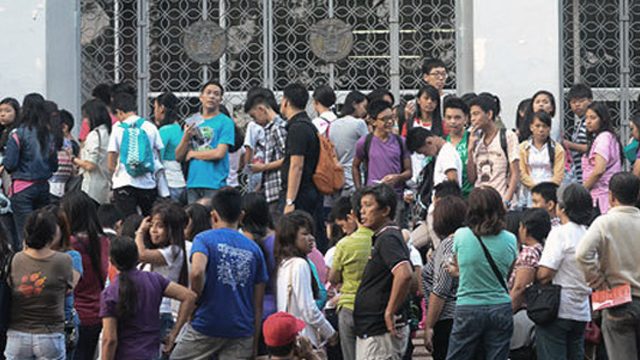SUMMARY
This is AI generated summarization, which may have errors. For context, always refer to the full article.

I noticed that some of my friends are conflicted about the new free tuition law that President Duterte signed recently. It sounds good and feels right, but some analysts have also pointed out its possibly disastrous consequences.
Here’s a simple thought experiment that zeroes in on the main problem with this law.
In the graph below, the orange bars show the distribution of students in state universities and colleges (SUCs) by income group. Focus on the leftmost and rightmost orange bars: they indicate that only 12% of SUC students come from the poorest income group, while as much as 17.2% come from the richest income group.
This graph is based on the 2014 APIS (Annual Poverty Indicators Survey). I’m not sure if the 2016 dataset is already available out there, but the latest figures are bound to look similar.
Note also that we are defining income groups in relative terms (based on “quintiles” or 5 groups of equal size), not in absolute terms (based on specified income thresholds).

This graph is important because it tells us who will benefit the most from the free tuition law.
Suppose we have P100 worth of tuition subsidies to be distributed among all SUC students regardless of their income. Further assume that the income distribution of students remains unchanged by the law.
Based on the graph above, the P100 worth of subsidies will be distributed to the students as follows:
- P17.2 will go to the 5th income quintile (richest)
- P23.8 will go to the 4th income quintile
- P24.3 will go to the 3rd income quintile
- P22.7 will go to the 2nd income quintile
- P12 will go to the 1st income quintile (poorest)
So a total of P41 will go to the richest 40% of students, but only P34.7 will go to the poorest 40% of students. The discrepancy is also large between the 2 extreme groups: P17.2 will go to the richest 20% of students, while only P12 will go to the poorest 20% of students.
You can play around the numbers any which way, but the data suggest that, by and large, the free tuition law is likely to benefit the rich more than the poor.
More subsidies for the rich

This regressive outcome is made worse by two things.
First, there’s reason to believe that the graph above underrepresents the richest students. Government surveys like APIS and FIES (Family Income and Expenditure Survey) typically don’t include responses from the richest households (say, the top 1% to 5%). Enumerators can’t easily access gated subdivisions and survey the rich inside their homes.
Hence, if we adjust for this bias in data collection, the rightmost orange bar should actually be taller (and the other bars shorter). This means that, for every P100 of tuition subsidies, more than P17.2 will go to those in the richest income group.
Second, the free tuition law is bound to make it even more difficult for the poorest students to enter SUCs. On August 7, a news report said that the Commission on Higher Education has instructed SUCs to tighten their admission policies once the free tuition law is fully in effect.
This is presumably because of the unusually large cohort of students expected to enter college in 2018: the big wave of K-12 graduates, plus the students from private colleges who will be enticed to transfer to SUCs because of the free tuition law.
This influx of enrollees is bound to swamp faculties and facilities in SUCs, and one way to stem the tide is to impose stricter admission policies. To the extent that the poor are relatively disadvantaged by their circumstances, it’s the richer students who are likelier to hurdle these increasingly stringent SUC admission policies.
Therefore, in the graph above, the bars to the right will become even taller come 2018, so even more tuition subsidies will go to the richest students at the expense of the rest.
‘Free’ is not necessarily pro-poor
We’ve barely touched the surface of the free tuition law’s bad effects. For example, we haven’t yet talked about the reckless nature by which it was passed: it didn’t enjoy the benefit of much debate and study, and it also didn’t incorporate a sound and well-thought-of fiscal strategy.
Asked how his government will fund the program, President Duterte said blankly on August 7, “Ewan ko.” (I don’t know.)
But our simple thought experiment already demonstrates the law’s most pernicious effect: it is likely to benefit the rich relatively more than the poor.
This new law admittedly deserves more detailed study, and it could take some years before we can observe its regressive impact – for instance, we need to revisit and reconstruct the graph above using 2018 data. Until then, lawmakers must find ways to mitigate such impact.
Some of them are proposing to limit the tuition subsidies to “deserving” students, and include the appropriate targeting mechanisms in the law’s implementing rules and regulations. But why pass a universal subsidy law that ends up being targeted anyway, because logic and practicality dictate it? Could they not have anticipated this eventuality?
Many Filipinos hailed the free tuition law as a “victory” for present and future generations, one that will automatically improve the poor’s ability to access tertiary education.
But providing something for “free” doesn’t necessarily make it pro-poor. By falling for this fundamental fallacy, we have ended up with a law that is patently reckless, ill-thought, and inequitable. – Rappler.com
The author is a PhD candidate at the UP School of Economics. His views are independent of the views of his affiliations. Follow JC on Twitter @jcpunongbayan.
Add a comment
How does this make you feel?
There are no comments yet. Add your comment to start the conversation.